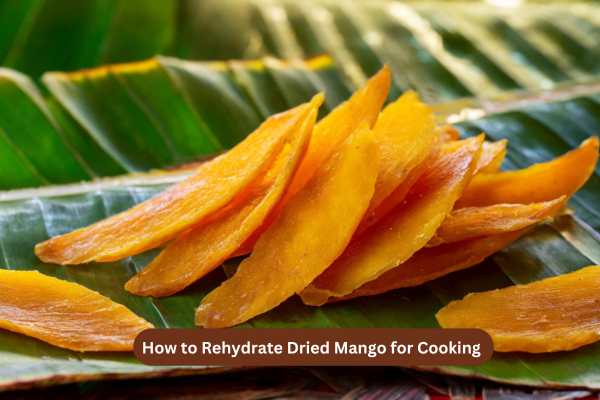Dried mango is a delicious, naturally sweet ingredient that adds a burst of tropical flavour to both sweet and savoury dishes. However, when using it for cooking or baking, rehydrating dried mango properly is key to achieving the right texture and taste. In this guide, we’ll walk you through the best techniques to rehydrate dried mango, ensuring it blends beautifully into your recipes.

Whether you’re preparing homemade cakes, chutneys, sauces, or desserts, understanding how to rehydrate dried mango can elevate your dishes to a whole new level.
Why Rehydrate Dried Mango?
Dried mango is naturally chewy and concentrated in flavour because its moisture has been removed during the drying process. While this makes it convenient for snacking, it can be too tough or leathery for certain recipes. Rehydrating softens the fruit, restoring its plump texture and juiciness, making it easier to chop, blend, or mix into batters and sauces.
Rehydration also releases more of the mango’s natural sweetness, enhancing the overall flavour profile of your dish. For recipes like muffins, chutneys, or tropical salads, using properly rehydrated mango ensures even distribution and better consistency.
Choosing the Right Dried Mango
Before rehydrating, it’s worth paying attention to the type of dried mango you’re using. In the UK, you’ll commonly find two varieties:
-
Unsweetened dried mango – pure mango with no added sugar, often slightly tangy and firmer.
-
Sweetened dried mango – softer and coated with sugar, ideal for desserts but less suitable for savoury dishes.
For cooking and baking, unsweetened dried mango is generally the best choice, as it gives you greater control over the sweetness of your final dish.
Always check the label for preservatives like sulphites, which can affect both taste and texture. Opt for natural or organic dried mango when possible.
How to Rehydrate Dried Mango – Step-by-Step
1. Prepare the Mango Pieces
Start by cutting the dried mango into smaller, bite-sized pieces if they are large. This helps them absorb water more evenly and makes them easier to incorporate into recipes.
2. Choose Your Liquid
Water is the most common and neutral option for rehydrating. However, depending on your recipe, you can experiment with other liquids to enhance flavour. Try using:
-
Fruit juice (such as orange or pineapple juice) for desserts or smoothies
-
Warm tea (like chamomile or black tea) for a subtle infusion
-
White rum or brandy for cakes and puddings, especially around festive seasons
3. Soak the Mango
Place the mango pieces in a heatproof bowl and pour enough warm liquid to completely cover them. Let them soak for 15–30 minutes, depending on how dry or thick the slices are.
If you’re short on time, you can use boiling water and reduce soaking time to 10–15 minutes. Avoid soaking for too long, as it can make the fruit mushy and cause it to lose flavour.
4. Drain and Pat Dry
Once the mango pieces are soft and plump, drain any excess liquid using a sieve or strainer. Gently pat them dry with a paper towel before adding them to your recipe. If you’re using them in baking, too much moisture can affect the batter’s texture.
5. Use the Soaking Liquid
Don’t throw away the soaking liquid—it’s infused with mango flavour! You can use it in smoothies, sauces, salad dressings, or even as a natural sweetener in baking.
Alternative Rehydration Method: Quick Simmer
If you prefer a faster method, you can simmer the dried mango on the hob:
-
Place the mango pieces in a small saucepan.
-
Add enough water or juice to cover them.
-
Simmer over low heat for 5–10 minutes, stirring occasionally, until soft and tender.
-
Let cool before using.
This method works well for chutneys, sauces, and fillings where a softer, jam-like texture is desired.
How to Use Rehydrated Mango in Recipes
Once rehydrated, dried mango can be used in countless ways. Here are some ideas popular in UK kitchens:
-
Baking: Add to muffins, scones, or flapjacks for a fruity burst.
-
Cooking: Mix into curries or chutneys for a balance of sweet and savoury.
-
Breakfasts: Stir into porridge, yoghurt, or overnight oats.
-
Desserts: Use as a topping for cheesecakes or blend into custards and puddings.
-
Smoothies: Combine with banana and coconut milk for a tropical drink.
The key is to match the flavour intensity of mango to your dish—its natural sweetness can replace sugar or complement tangy or spicy flavours beautifully.
Tips for Perfect Results
-
Use warm liquid: It speeds up absorption and softens the fruit more evenly.
-
Test texture: The mango should be soft but still hold its shape—avoid over-soaking.
-
Adjust sweetness: If your dried mango is sweetened, reduce other sugars in your recipe.
-
Store leftovers properly: Keep unused rehydrated mango in an airtight container in the fridge for up to 3 days.
Common Mistakes to Avoid
-
Using cold water: It slows down the rehydration process and leads to uneven texture.
-
Over-soaking: Too much liquid makes mango pieces soggy and flavourless.
-
Skipping the drying step: Excess moisture can affect baking results or cause spoilage.
-
Discarding soaking liquid: It’s full of natural flavour—save it for creative use.
Final Thoughts
Rehydrating dried mango for cooking and baking is simple but transformative. With just a little preparation, you can bring dried mango back to life, ready to enhance your favourite dishes with vibrant colour, tropical aroma, and natural sweetness.
Whether you’re making a fruity loaf cake, a tangy chutney, or a refreshing smoothie, mastering the art of rehydrating dried mango ensures your recipes shine with both flavour and texture. Try it once, and you’ll never go back to tossing dry, chewy pieces into your batter again.

